21.5-inch iMac (Late 2013) Review: Iris Pro Driving an Accurate Display
by Anand Lal Shimpi on October 7, 2013 3:28 AM ESTWiFi & IO
The new iMacs join the 2013 MacBook Airs in supporting 802.11ac. Unlike the MBA implementation however, the iMac features a 3 antenna/3 stream configuration with the potential for even higher performance. Connected to Apple’s new 802.11ac Airport Extreme I was able to negotiate the maximum link rate of 1300Mbps. I will say that maintaining the full speed connection was quite tricky and required very close proximity to the AP, and that the AP was located physically higher than the iMac.

Range was absolutely incredible on the Airport Extreme/2013 iMac combination. I didn’t have time to map out speed vs. distance from AP before leaving on my most recent trip, but I will say that the combination of the two gave me better WiFi range/performance than any other wireless device I’ve ever tested. I need to spend some more time with the two but color me completely impressed at this point.
With OS X 10.8.5 Apple addressed some of the performance issues that plagued real world use of 802.11ac. Prior to the 10.8.5 update,I could get great performance using iPerf, but actually copying files between Macs on the same network never substantially exceeded the performance I could get over 802.11n.
The 10.8.5 update somewhat addressed the problem, raising average performance copying over an AFP share to ~330Mbps. It’s not unusual for software companies to only partially address an issue in existing software, especially if there’s an actual fix coming just around the corner. I had a suspicion that’s what was going on here so I threw OS X 10.9 (Mavericks) on both the iMac and my source machine, a 13-inch MacBook Pro with Retina Display.
The 13-inch rMBP was connected over Thunderbolt/GigE, while the iMac was connected over 802.11ac to the same network. First, let’s look at UDP and TCP performance using iPerf:
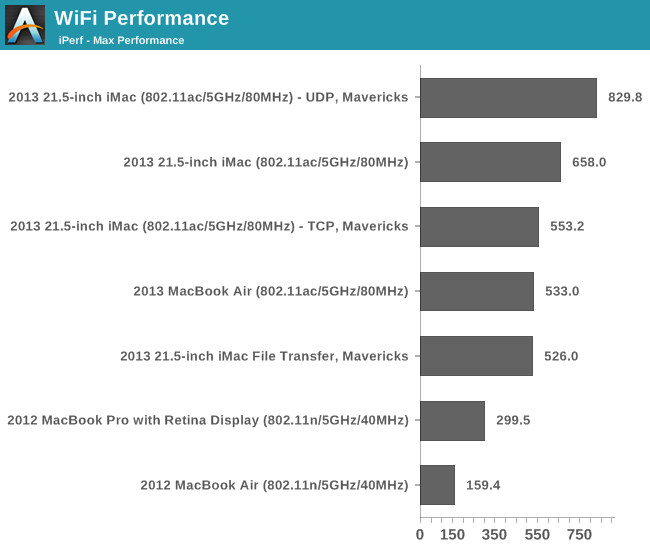
Peak UDP performance is 829.8Mbps. Running the same test using TCP drops performance down to 553Mbps. What about actual file copy performance? I saw peak performance as high as 720Mbps, but average file copy speed over my network setup was ~500Mbps.

You can definitely get better transfer speeds over wired Gigabit Ethernet, but 802.11ac (particularly over short distances) is very good. You’ll need to wait for Mavericks to really enjoy this performance, but the wait is almost over.
The rest of the IO is the same as in last year's model. You get four USB 3.0 ports, two Thunderbolt 1.0 ports, GigE, SD card reader, and a 1/8" jack:
The Chassis
Last year Apple redesigned the iMac, making it thinner at the edges than an iPhone 5/5s or even an iPad mini. Many pointed out that reducing edge thickness didn’t really matter all that much given the center of the iMac bulges out quite a bit. Given that there’s no internal battery you need more space for, reducing chassis volume is purely an exercise in design with no real tradeoffs as long as you can adequately cool what’s inside. I can’t speak to the 21.5-inch iMacs with discrete graphics, but the 65W Haswell + Crystalwell model I was sampled exhibited no thermal issues during even heavy use.
The iMac’s lone internal fan hummed along at ~1400 RPM during light use as well as during repeated Cinebench R15 runs while writing this review. One positive side effect of Intel targeting notebooks for all of its microprocessor architectures is the ease of cooling these 65W “desktop” parts. Keep in mind that Apple delivers a similar amount of performance in a very thin 15-inch notebook chassis as it does in a 21.5-inch iMac chassis.
Despite the reduction in internal volume, the redesigned 27-inch iMac is still a bit bulky to move around. The same can’t be said for the 21.5-inch model however. Weighing only 12 pounds (the equivalent of a small dog or large cat), the 21.5-inch iMac is almost portable. I had to carry it around a lot during the course of my review (between desks, photo area, and in testing WiFi) and I quickly appreciated just how compact this system is. Particularly in its default configuration, there’s only a single cable you have to deal with: the carefully angled power cable going into the machine.
It’s also neat to look at the iMac compared to one of my 24-inch CPU testbed monitors from a few years ago and realize that the two have virtually the same resolution, and the iMac is not only a better display but comes with an integrated Haswell PC as well.


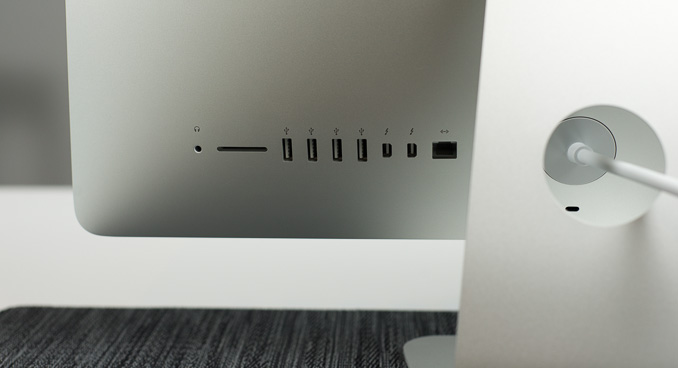
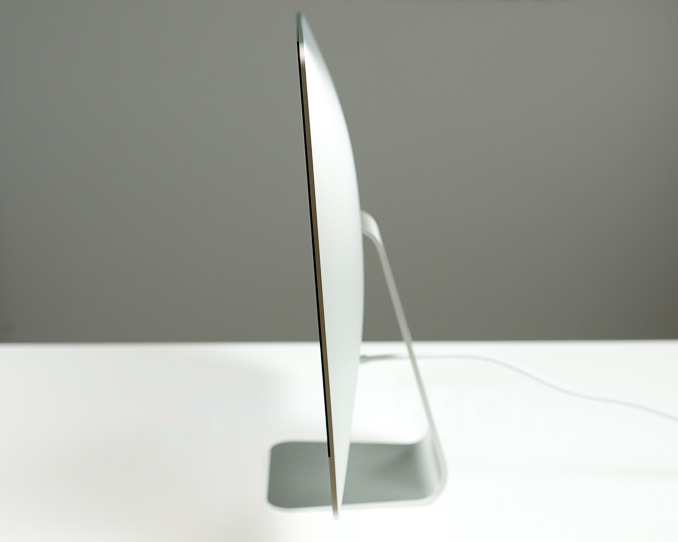
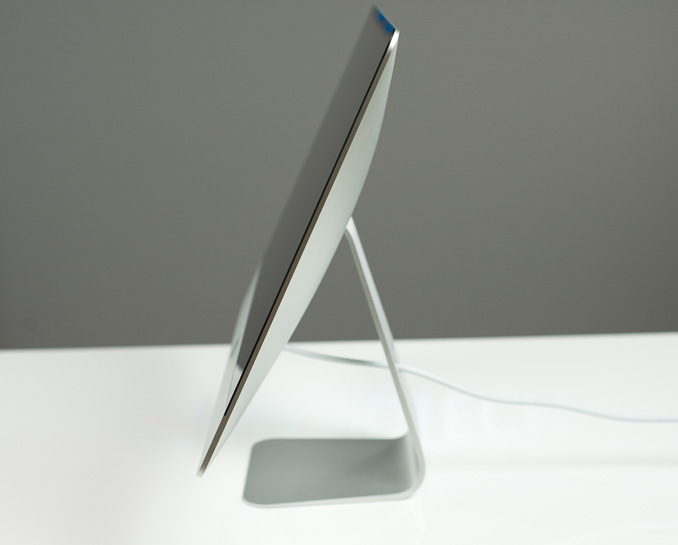
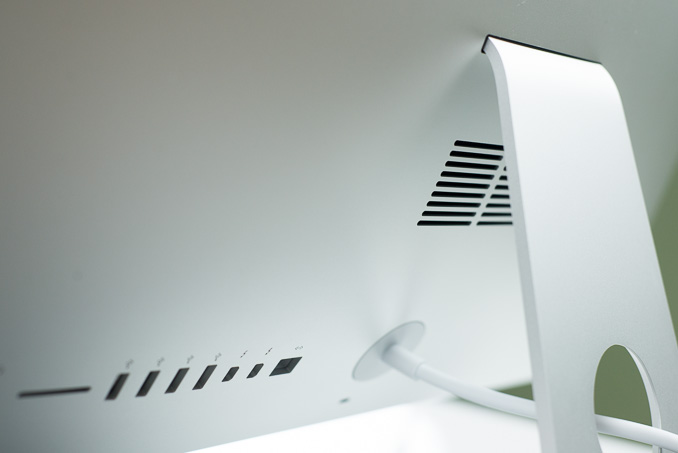








127 Comments
View All Comments
BiggieShady - Monday, October 7, 2013 - link
Nice iris vs. geforce gaming comparison. I would love to see temperature and fan speed comparison.name99 - Monday, October 7, 2013 - link
It is crazy how cool these things run. I have a late 2012 27" i7 iMac and there is no part of it that is close to hot. The fan dumps hot air through a single hole which is very cleverly hidden below the hinge of the base so you don't even feel that unless you really look for it.Even when I've run the thing at max performance, having eight Mathematica kernels running in parallel for fifteen min or so, there's no obvious heating and no obvious fan noise.
The difference with even as recent as the 2007 iMac (my last model) is night and day. Part is the much more efficient CPUs, part is also the much more efficient display.
odaiwai - Monday, October 7, 2013 - link
How do you see the actual CPU current speed on an intel Mac? I've been looking for a utility to do that for ages.abazigal - Monday, October 7, 2013 - link
All this points to the possibility of a 15" retina macbook pro using only integrated graphics, which means comparable performance, with even longer battery life.Fun times ahead!
dylan522p - Monday, October 7, 2013 - link
Probably only low end MBPr will do that this year, but next year if 6200 or whatever the Broadwell graphics are improved enough then very likely that could happen.tipoo - Thursday, October 10, 2013 - link
I hope they go the other way with it. GT3e for the 13" duo (especially for the retina, that would be a boon),and keep higher end discreet graphics in the larger models.lefty2 - Monday, October 7, 2013 - link
You forgot to mention that the fusion drive is not supported by Windows (if you are using bootcamp)"If you partition the drive, the new partition will not be part of the logical-volume group that Fusion Drive uses, so it will not benefit from the speed of the SSD"
http://reviews.cnet.com/8301-13727_7-57549766-263/...
ananduser - Monday, October 7, 2013 - link
Man that Iris looks a lot worse in reality than I expected it to be. You really have to crank down the resolution and details to get some decent gaming performance. Then again this is the base imac, it's got compromise written all over it.CharonPDX - Monday, October 7, 2013 - link
Correction: You state "By default all of the iMacs come with a 3.5” mechanical hard drive."iFixIt has shown that the 21.5" iMacs now come with 2.5" mechanical hard drives by default, not 3.5".
AlValentyn - Monday, October 7, 2013 - link
Looks like my 2010 Mac Pro with 3.33 Hex core is still going strong. Finally going to add an SSD to it, and now I'm just waiting to see what AMD's R9 series GPU's are like.It is impressive to see how well these iMacs are doing these days though. :)